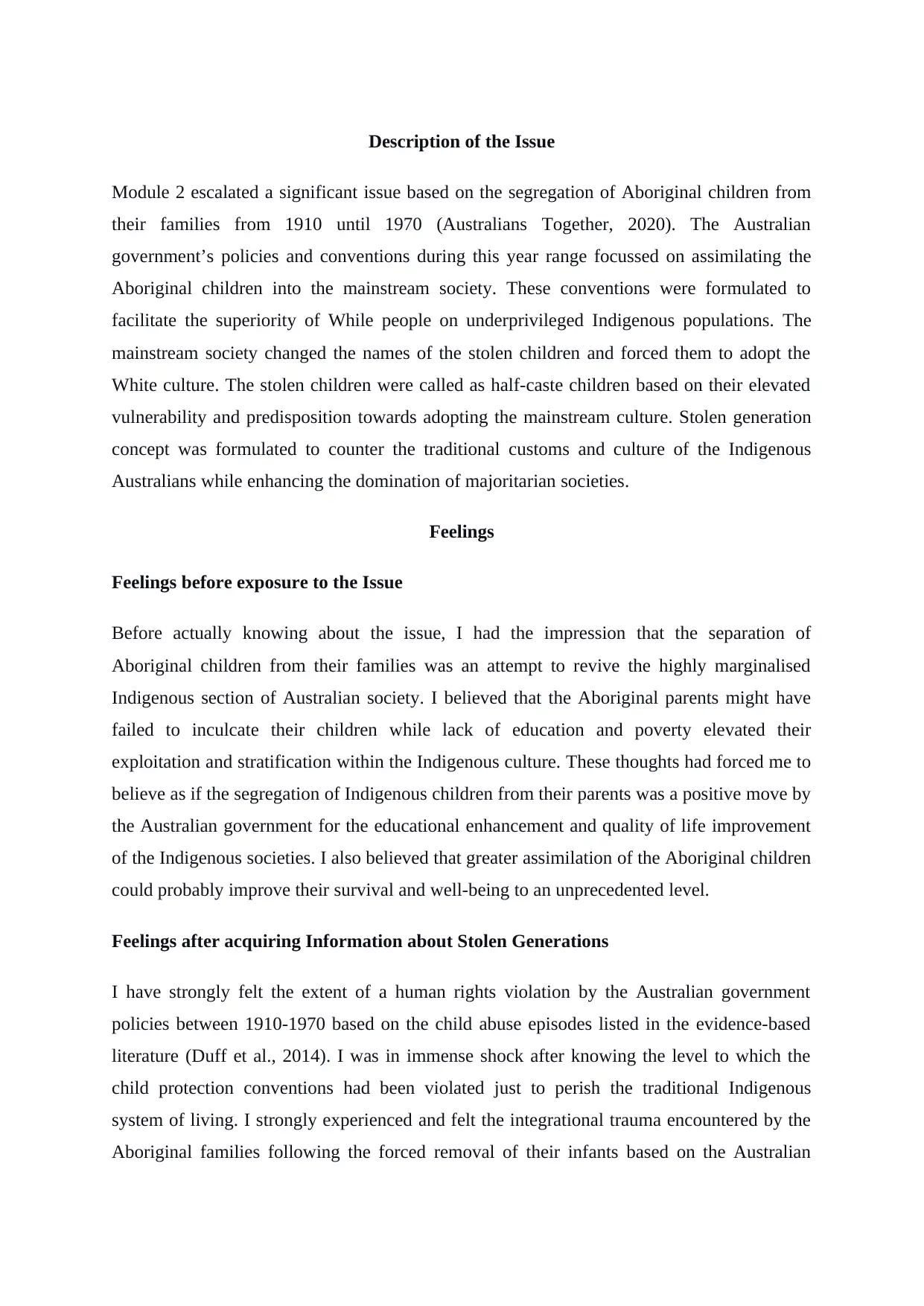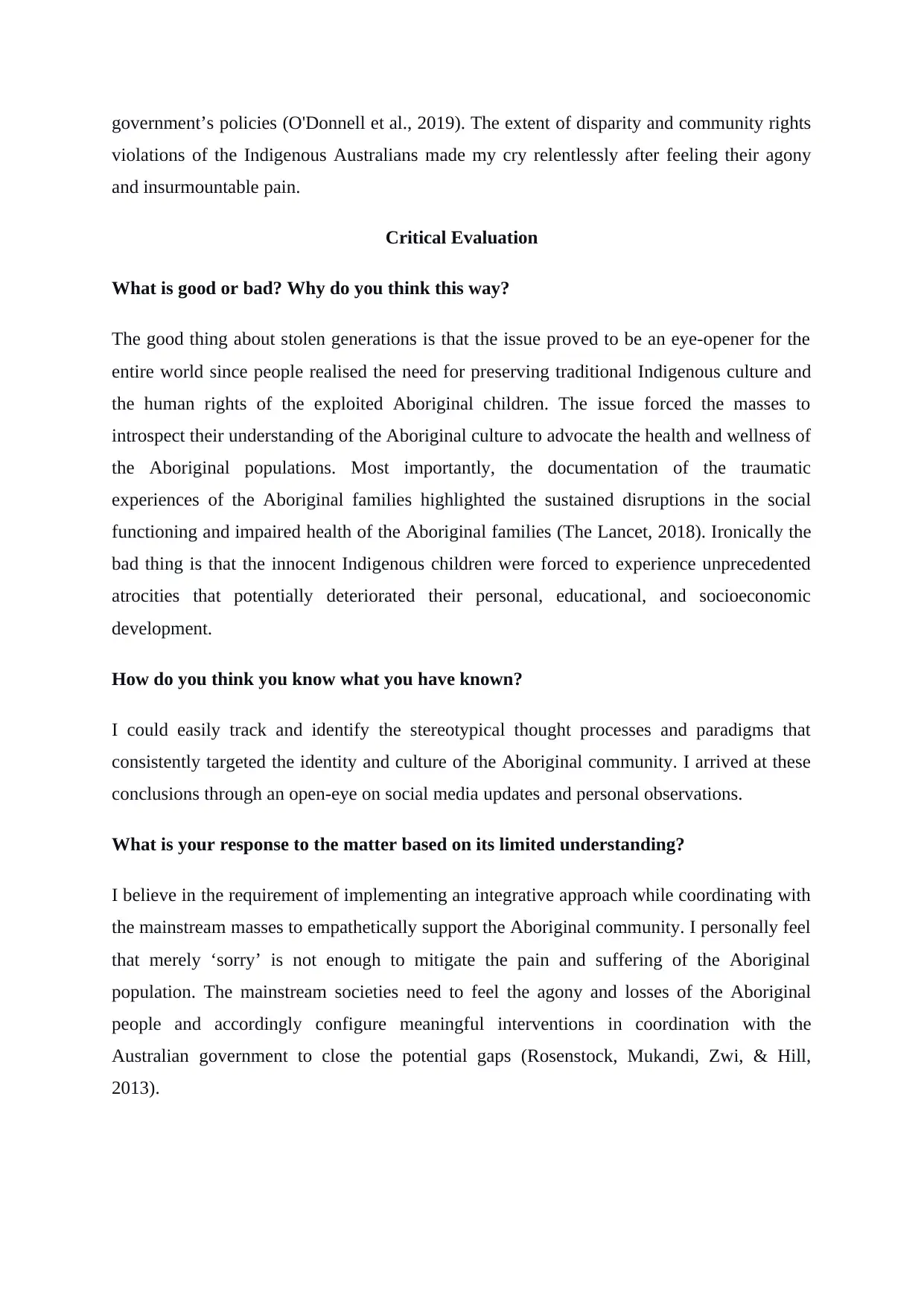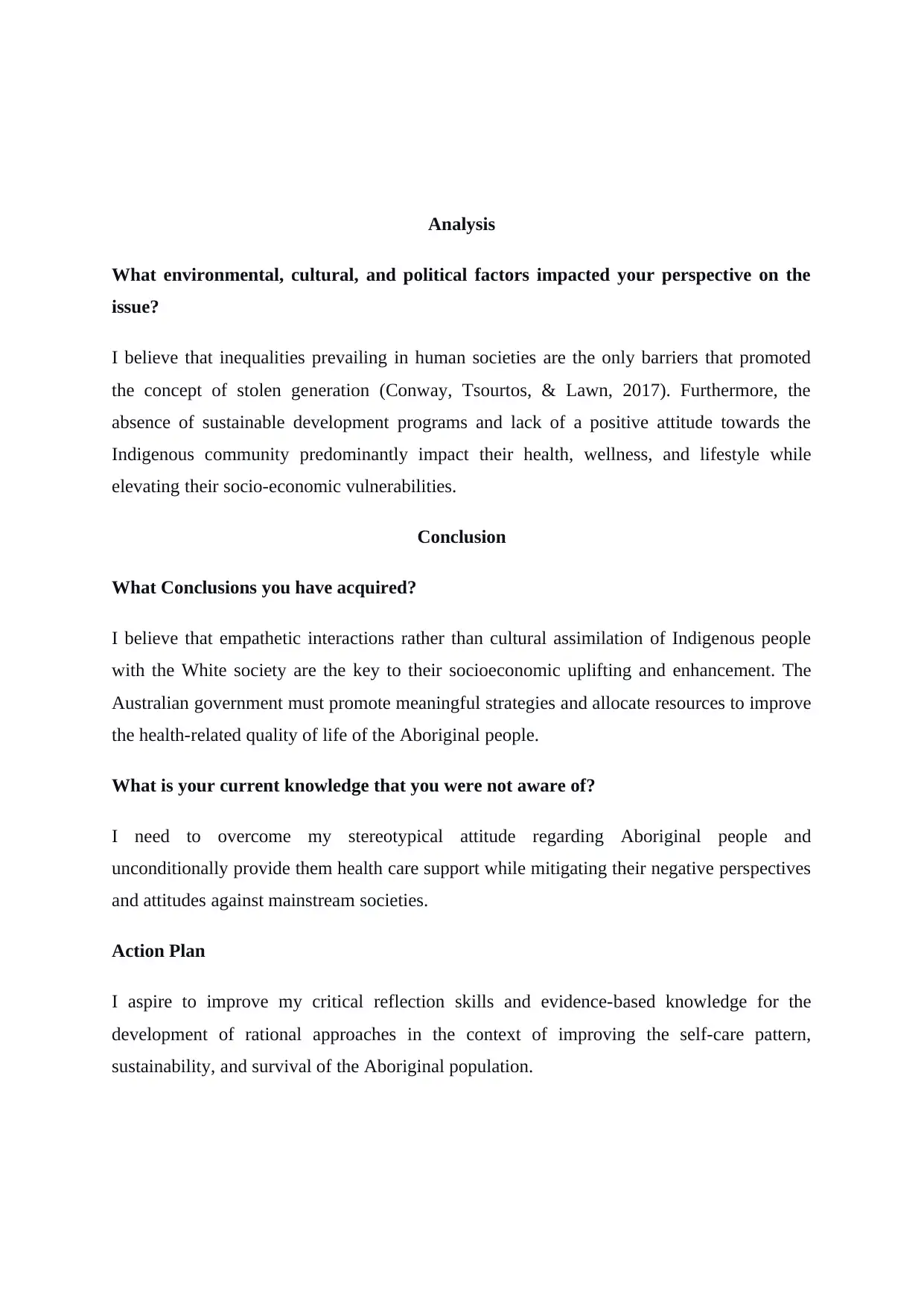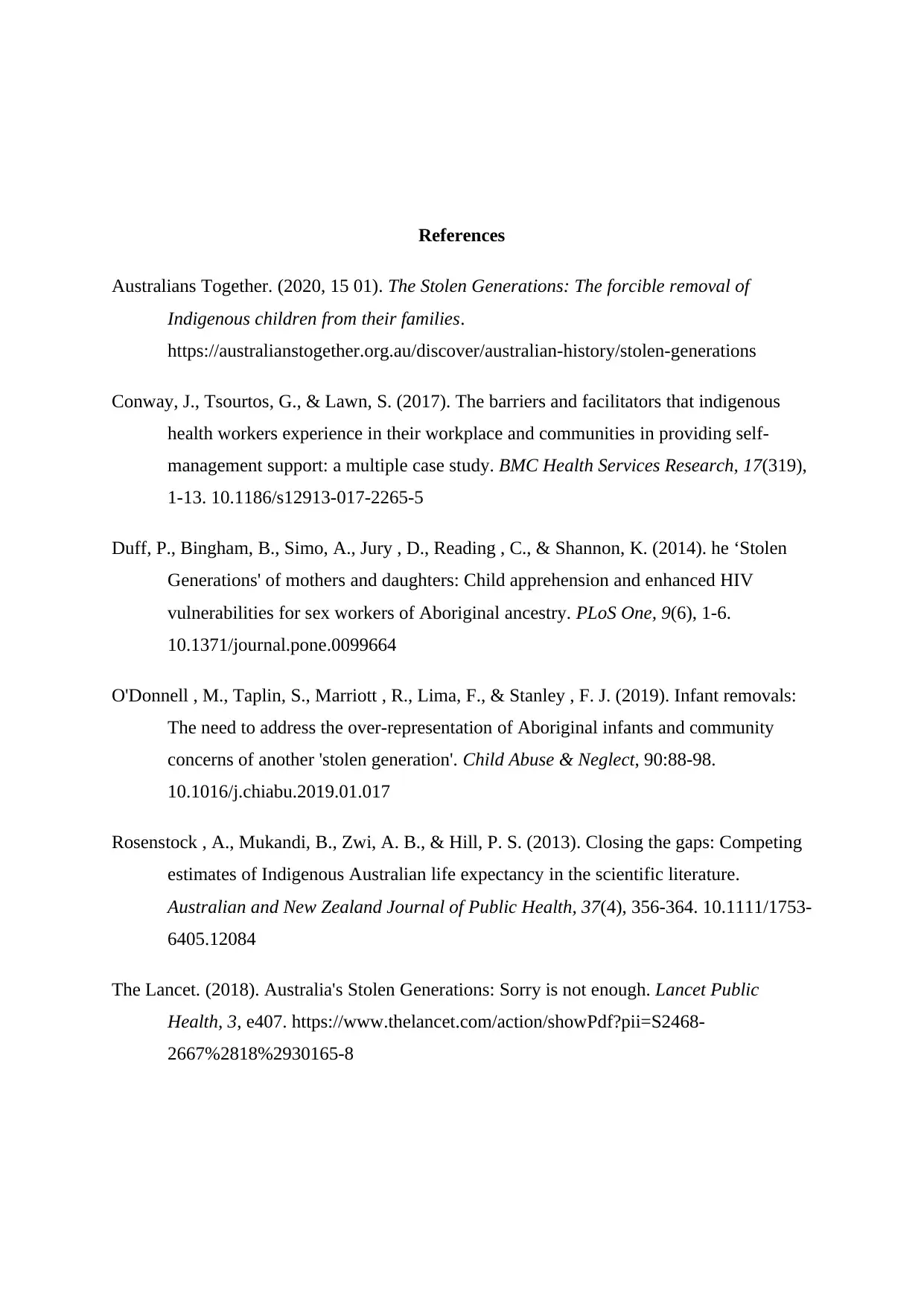Segregation of Aboriginal Children | Report
VerifiedAdded on 2022/09/18
|5
|1189
|22
AI Summary
Contribute Materials
Your contribution can guide someone’s learning journey. Share your
documents today.

Description of the Issue
Module 2 escalated a significant issue based on the segregation of Aboriginal children from
their families from 1910 until 1970 (Australians Together, 2020). The Australian
government’s policies and conventions during this year range focussed on assimilating the
Aboriginal children into the mainstream society. These conventions were formulated to
facilitate the superiority of While people on underprivileged Indigenous populations. The
mainstream society changed the names of the stolen children and forced them to adopt the
White culture. The stolen children were called as half-caste children based on their elevated
vulnerability and predisposition towards adopting the mainstream culture. Stolen generation
concept was formulated to counter the traditional customs and culture of the Indigenous
Australians while enhancing the domination of majoritarian societies.
Feelings
Feelings before exposure to the Issue
Before actually knowing about the issue, I had the impression that the separation of
Aboriginal children from their families was an attempt to revive the highly marginalised
Indigenous section of Australian society. I believed that the Aboriginal parents might have
failed to inculcate their children while lack of education and poverty elevated their
exploitation and stratification within the Indigenous culture. These thoughts had forced me to
believe as if the segregation of Indigenous children from their parents was a positive move by
the Australian government for the educational enhancement and quality of life improvement
of the Indigenous societies. I also believed that greater assimilation of the Aboriginal children
could probably improve their survival and well-being to an unprecedented level.
Feelings after acquiring Information about Stolen Generations
I have strongly felt the extent of a human rights violation by the Australian government
policies between 1910-1970 based on the child abuse episodes listed in the evidence-based
literature (Duff et al., 2014). I was in immense shock after knowing the level to which the
child protection conventions had been violated just to perish the traditional Indigenous
system of living. I strongly experienced and felt the integrational trauma encountered by the
Aboriginal families following the forced removal of their infants based on the Australian
Module 2 escalated a significant issue based on the segregation of Aboriginal children from
their families from 1910 until 1970 (Australians Together, 2020). The Australian
government’s policies and conventions during this year range focussed on assimilating the
Aboriginal children into the mainstream society. These conventions were formulated to
facilitate the superiority of While people on underprivileged Indigenous populations. The
mainstream society changed the names of the stolen children and forced them to adopt the
White culture. The stolen children were called as half-caste children based on their elevated
vulnerability and predisposition towards adopting the mainstream culture. Stolen generation
concept was formulated to counter the traditional customs and culture of the Indigenous
Australians while enhancing the domination of majoritarian societies.
Feelings
Feelings before exposure to the Issue
Before actually knowing about the issue, I had the impression that the separation of
Aboriginal children from their families was an attempt to revive the highly marginalised
Indigenous section of Australian society. I believed that the Aboriginal parents might have
failed to inculcate their children while lack of education and poverty elevated their
exploitation and stratification within the Indigenous culture. These thoughts had forced me to
believe as if the segregation of Indigenous children from their parents was a positive move by
the Australian government for the educational enhancement and quality of life improvement
of the Indigenous societies. I also believed that greater assimilation of the Aboriginal children
could probably improve their survival and well-being to an unprecedented level.
Feelings after acquiring Information about Stolen Generations
I have strongly felt the extent of a human rights violation by the Australian government
policies between 1910-1970 based on the child abuse episodes listed in the evidence-based
literature (Duff et al., 2014). I was in immense shock after knowing the level to which the
child protection conventions had been violated just to perish the traditional Indigenous
system of living. I strongly experienced and felt the integrational trauma encountered by the
Aboriginal families following the forced removal of their infants based on the Australian
Secure Best Marks with AI Grader
Need help grading? Try our AI Grader for instant feedback on your assignments.

government’s policies (O'Donnell et al., 2019). The extent of disparity and community rights
violations of the Indigenous Australians made my cry relentlessly after feeling their agony
and insurmountable pain.
Critical Evaluation
What is good or bad? Why do you think this way?
The good thing about stolen generations is that the issue proved to be an eye-opener for the
entire world since people realised the need for preserving traditional Indigenous culture and
the human rights of the exploited Aboriginal children. The issue forced the masses to
introspect their understanding of the Aboriginal culture to advocate the health and wellness of
the Aboriginal populations. Most importantly, the documentation of the traumatic
experiences of the Aboriginal families highlighted the sustained disruptions in the social
functioning and impaired health of the Aboriginal families (The Lancet, 2018). Ironically the
bad thing is that the innocent Indigenous children were forced to experience unprecedented
atrocities that potentially deteriorated their personal, educational, and socioeconomic
development.
How do you think you know what you have known?
I could easily track and identify the stereotypical thought processes and paradigms that
consistently targeted the identity and culture of the Aboriginal community. I arrived at these
conclusions through an open-eye on social media updates and personal observations.
What is your response to the matter based on its limited understanding?
I believe in the requirement of implementing an integrative approach while coordinating with
the mainstream masses to empathetically support the Aboriginal community. I personally feel
that merely ‘sorry’ is not enough to mitigate the pain and suffering of the Aboriginal
population. The mainstream societies need to feel the agony and losses of the Aboriginal
people and accordingly configure meaningful interventions in coordination with the
Australian government to close the potential gaps (Rosenstock, Mukandi, Zwi, & Hill,
2013).
violations of the Indigenous Australians made my cry relentlessly after feeling their agony
and insurmountable pain.
Critical Evaluation
What is good or bad? Why do you think this way?
The good thing about stolen generations is that the issue proved to be an eye-opener for the
entire world since people realised the need for preserving traditional Indigenous culture and
the human rights of the exploited Aboriginal children. The issue forced the masses to
introspect their understanding of the Aboriginal culture to advocate the health and wellness of
the Aboriginal populations. Most importantly, the documentation of the traumatic
experiences of the Aboriginal families highlighted the sustained disruptions in the social
functioning and impaired health of the Aboriginal families (The Lancet, 2018). Ironically the
bad thing is that the innocent Indigenous children were forced to experience unprecedented
atrocities that potentially deteriorated their personal, educational, and socioeconomic
development.
How do you think you know what you have known?
I could easily track and identify the stereotypical thought processes and paradigms that
consistently targeted the identity and culture of the Aboriginal community. I arrived at these
conclusions through an open-eye on social media updates and personal observations.
What is your response to the matter based on its limited understanding?
I believe in the requirement of implementing an integrative approach while coordinating with
the mainstream masses to empathetically support the Aboriginal community. I personally feel
that merely ‘sorry’ is not enough to mitigate the pain and suffering of the Aboriginal
population. The mainstream societies need to feel the agony and losses of the Aboriginal
people and accordingly configure meaningful interventions in coordination with the
Australian government to close the potential gaps (Rosenstock, Mukandi, Zwi, & Hill,
2013).

Analysis
What environmental, cultural, and political factors impacted your perspective on the
issue?
I believe that inequalities prevailing in human societies are the only barriers that promoted
the concept of stolen generation (Conway, Tsourtos, & Lawn, 2017). Furthermore, the
absence of sustainable development programs and lack of a positive attitude towards the
Indigenous community predominantly impact their health, wellness, and lifestyle while
elevating their socio-economic vulnerabilities.
Conclusion
What Conclusions you have acquired?
I believe that empathetic interactions rather than cultural assimilation of Indigenous people
with the White society are the key to their socioeconomic uplifting and enhancement. The
Australian government must promote meaningful strategies and allocate resources to improve
the health-related quality of life of the Aboriginal people.
What is your current knowledge that you were not aware of?
I need to overcome my stereotypical attitude regarding Aboriginal people and
unconditionally provide them health care support while mitigating their negative perspectives
and attitudes against mainstream societies.
Action Plan
I aspire to improve my critical reflection skills and evidence-based knowledge for the
development of rational approaches in the context of improving the self-care pattern,
sustainability, and survival of the Aboriginal population.
What environmental, cultural, and political factors impacted your perspective on the
issue?
I believe that inequalities prevailing in human societies are the only barriers that promoted
the concept of stolen generation (Conway, Tsourtos, & Lawn, 2017). Furthermore, the
absence of sustainable development programs and lack of a positive attitude towards the
Indigenous community predominantly impact their health, wellness, and lifestyle while
elevating their socio-economic vulnerabilities.
Conclusion
What Conclusions you have acquired?
I believe that empathetic interactions rather than cultural assimilation of Indigenous people
with the White society are the key to their socioeconomic uplifting and enhancement. The
Australian government must promote meaningful strategies and allocate resources to improve
the health-related quality of life of the Aboriginal people.
What is your current knowledge that you were not aware of?
I need to overcome my stereotypical attitude regarding Aboriginal people and
unconditionally provide them health care support while mitigating their negative perspectives
and attitudes against mainstream societies.
Action Plan
I aspire to improve my critical reflection skills and evidence-based knowledge for the
development of rational approaches in the context of improving the self-care pattern,
sustainability, and survival of the Aboriginal population.

References
Australians Together. (2020, 15 01). The Stolen Generations: The forcible removal of
Indigenous children from their families.
https://australianstogether.org.au/discover/australian-history/stolen-generations
Conway, J., Tsourtos, G., & Lawn, S. (2017). The barriers and facilitators that indigenous
health workers experience in their workplace and communities in providing self-
management support: a multiple case study. BMC Health Services Research, 17(319),
1-13. 10.1186/s12913-017-2265-5
Duff, P., Bingham, B., Simo, A., Jury , D., Reading , C., & Shannon, K. (2014). he ‘Stolen
Generations' of mothers and daughters: Child apprehension and enhanced HIV
vulnerabilities for sex workers of Aboriginal ancestry. PLoS One, 9(6), 1-6.
10.1371/journal.pone.0099664
O'Donnell , M., Taplin, S., Marriott , R., Lima, F., & Stanley , F. J. (2019). Infant removals:
The need to address the over-representation of Aboriginal infants and community
concerns of another 'stolen generation'. Child Abuse & Neglect, 90:88-98.
10.1016/j.chiabu.2019.01.017
Rosenstock , A., Mukandi, B., Zwi, A. B., & Hill, P. S. (2013). Closing the gaps: Competing
estimates of Indigenous Australian life expectancy in the scientific literature.
Australian and New Zealand Journal of Public Health, 37(4), 356-364. 10.1111/1753-
6405.12084
The Lancet. (2018). Australia's Stolen Generations: Sorry is not enough. Lancet Public
Health, 3, e407. https://www.thelancet.com/action/showPdf?pii=S2468-
2667%2818%2930165-8
Australians Together. (2020, 15 01). The Stolen Generations: The forcible removal of
Indigenous children from their families.
https://australianstogether.org.au/discover/australian-history/stolen-generations
Conway, J., Tsourtos, G., & Lawn, S. (2017). The barriers and facilitators that indigenous
health workers experience in their workplace and communities in providing self-
management support: a multiple case study. BMC Health Services Research, 17(319),
1-13. 10.1186/s12913-017-2265-5
Duff, P., Bingham, B., Simo, A., Jury , D., Reading , C., & Shannon, K. (2014). he ‘Stolen
Generations' of mothers and daughters: Child apprehension and enhanced HIV
vulnerabilities for sex workers of Aboriginal ancestry. PLoS One, 9(6), 1-6.
10.1371/journal.pone.0099664
O'Donnell , M., Taplin, S., Marriott , R., Lima, F., & Stanley , F. J. (2019). Infant removals:
The need to address the over-representation of Aboriginal infants and community
concerns of another 'stolen generation'. Child Abuse & Neglect, 90:88-98.
10.1016/j.chiabu.2019.01.017
Rosenstock , A., Mukandi, B., Zwi, A. B., & Hill, P. S. (2013). Closing the gaps: Competing
estimates of Indigenous Australian life expectancy in the scientific literature.
Australian and New Zealand Journal of Public Health, 37(4), 356-364. 10.1111/1753-
6405.12084
The Lancet. (2018). Australia's Stolen Generations: Sorry is not enough. Lancet Public
Health, 3, e407. https://www.thelancet.com/action/showPdf?pii=S2468-
2667%2818%2930165-8
Secure Best Marks with AI Grader
Need help grading? Try our AI Grader for instant feedback on your assignments.

1 out of 5
Related Documents
Your All-in-One AI-Powered Toolkit for Academic Success.
+13062052269
info@desklib.com
Available 24*7 on WhatsApp / Email
![[object Object]](/_next/static/media/star-bottom.7253800d.svg)
Unlock your academic potential
© 2024 | Zucol Services PVT LTD | All rights reserved.




